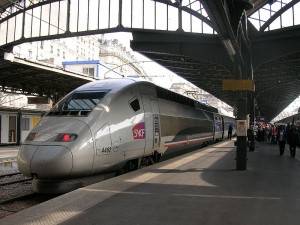 Amidst a recession, in a state buried deep in debt, surrounded by controversy and led by an interim Governor, high-speed rail might seem like the last thing to throw billions of dollars at. Many tax-paying Illinois residents, as well as local governments and organizations, are opposed to the idea. The reason for this? Lack of necessity, cost of upkeep and operation, and environmental impact, just to name a few.
Amidst a recession, in a state buried deep in debt, surrounded by controversy and led by an interim Governor, high-speed rail might seem like the last thing to throw billions of dollars at. Many tax-paying Illinois residents, as well as local governments and organizations, are opposed to the idea. The reason for this? Lack of necessity, cost of upkeep and operation, and environmental impact, just to name a few.
However, as the cost of travel has increased in the past decade, the public has strayed from the airlines and gas-guzzling autos and turned to more economically-reasonable means of transportation, specifically bus and rail.
The current proposal for high-speed rail in the Midwest hopes to decrease travel time, lower cost, and rid the highways of both commuters and freight, resulting in a significant environmental impact. With Chicago as the regional hub, lines would run to St. Louis with intermediate stops in Champaign and Springfield, to Cleveland via Indiana, Milwaukee and Madison, and possibly the Twin Cities, Cincinnati and eventually parts of Kentucky. The proposed trains would run at either 110 or 220 MPH, depending on the line, and cut travel time between Chicago and St. Louis to less than two hours, and between Chicago and Champaign to only 45 minutes.
So, is this multibillion dollar investment worth the effort? Let’s look at the history of high-speed rail.
High-speed rail is nothing new to the United States. As early as the 1930s, two of the nation’s largest railroads had forms of high-speed rail in operation. But these were soon replaced by larger (and slower) locomotives capable of carrying more freight longer distances. In the 1950s and ’60s, high-speed rail rallied with a bit of a comeback, but the convenience of air travel and the expansion of the U.S. Interstate System quickly killed the idea of travel by train. Is this destined to happen again?
Currently, the United States has only one rail line that can be designated as “high speed,” Amtrak’s Acela Express, serving the Northeast corridor, from Boston/New York to Washington D.C. This 470 miles of line is trumped by nearly every major European nation, Japan, China and Russia. However, just this past February, as part of the American Recovery and Reinvestment Act (ARRA), the federal government allocated $8 billion towards the research, development and implementation of High Speed Rail.
While this $8 billion is a mere one percent of the total stimulus package, it is perhaps the most coveted of all federal dollars put forth by the ARRA. Earlier this year, the federal government started accepting initial applications for the funds. Over 100 applications came in within the first few months. As of October 12, a total of $50 billion was sought by 24 states. It goes without saying that the desire for high-speed rail in the United States is real. And here in Illinois, politicians and the public alike are showing support for the proposal.
On October 10, Chicago hosted the 2009 Midwest High Speed Rail Fall Conference, to both celebrate and discuss the initial $850 million Illinois appropriation for railroad infrastructure and development. Governor Quinn, the keynote speaker of the event, met with members of the Midwest High Speed Rail Association at this annual pep rally for high-speed rail. This year at the conference, attendees more than just a sense of hope for high-speed rail, they had actual funds and a plan. But the following Monday, Quinn would face opposition to the proposal.
The governor was back in Springfield on October 12, where he called high-speed rail “a mission for America.”
However, local residents expressed opposition to the plan to use Springfield as a corridor for the Chicago to St. Louis rail line, stating that construction and the final project would cause a major setback for the future growth of the newly revitalized downtown area and conjoining neighborhoods. While the City of Springfield is not opposed to high-speed rail, they are not satisfied with the location of the proposed line. In response, Quinn urged that “[the plan] shouldn’t be stopped by local opposition,” but that “the state is willing to look at alternative routes.”
Over the past few months, Springfield has battled the Illinois Department of Transportation, Union Pacific and is now fighting at the federal level to stop the rail line from passing through the Third Street district. Alderman sponsoring the opposition have sought the help of Senator Dick Durbin to fight the rail proposal. Currently, they have no resolution.
As we await a resolution, or concession from Springfield, the U.S. High Speed Rail Association gets ready to hold it’s annual conference this coming weekend. Expected to speak at the conference is Richard Harnish, Executive Director of Midwest High Speed Rail Association in Chicago. Harnish has been working to develop High Speed Rail in the Midwest for nearly 15 years. It appears that his hard work may finally be paying off. According to the U.S. HSRA, the Midwest is one of the leading regions expected to receive major funding from the federal government for high speed rail.
While it may be years before any construction begins on high-speed rail in Illinois, it seems that we will have an answer to whether or not we will ever see 220 MPH lines in the state, and just how much funding the region will receive, very soon.
In the second part of this series, we’ll talk with local politicians, residents and public transportation officials for some perspective on the issue of High Speed Rail.








